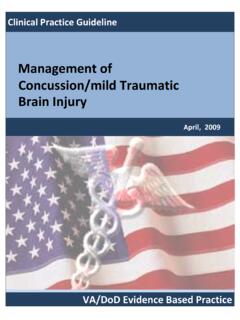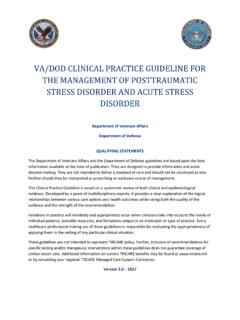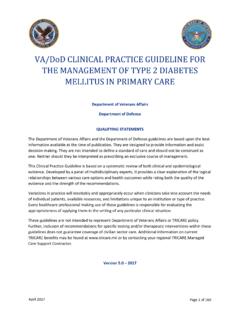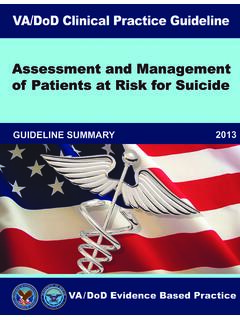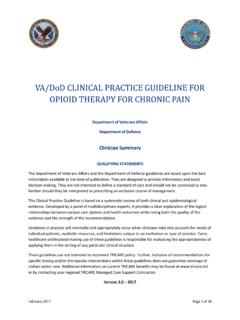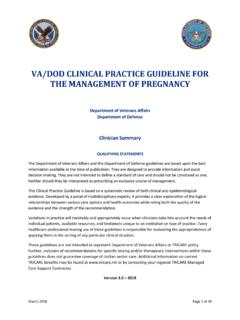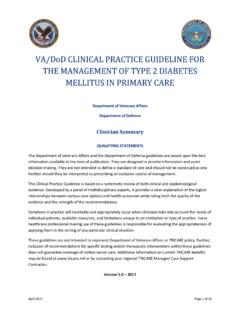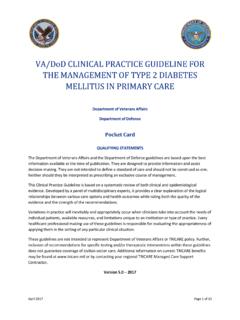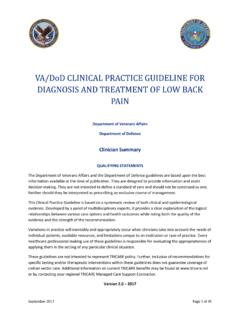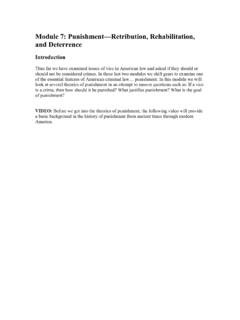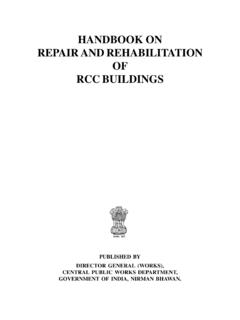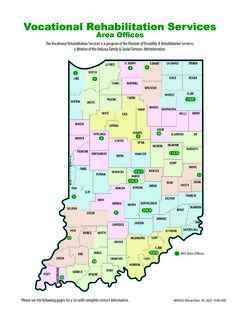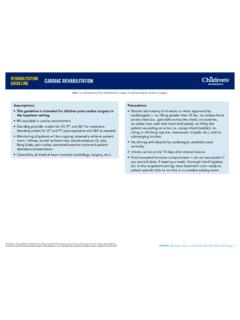Transcription of Amputation Rehabilitation Guideline Summary
1 Department of Veterans affairsDepartment of DefenseVA/DoD Clinical Practice Guidelinefor Management of Upper Extremity Amputation RehabilitationGuideline SummaryPrepared by:The Management of Upper Extremity Amputation Rehabilitation GroupWith support from:The Office of Quality, Safety and Value, VA, Washington, DCandQuality Performance Assurance Directorate, United States Army MEDCOMFull Guideline available at: or STATEMENTSThe Department of Veterans Affairs (VA) and The Department of Defense (DoD) guidelines are based upon the best information available at the time of publication. They are designed to provide information and assist decision-making.
2 They are not intended to define a standard of care and should not be construed as one. Neither should they be interpreted as prescribing an exclusive course of in practice will inevitably and appropriately occur when providers take into account the needs of individual patients, available resources, and limitations unique to an institution or type of practice. Every health care professional making use of these guidelines is responsible for evaluating the appropriateness of applying them in the setting of any particular clinical situation. Version 20142 | Guideline Summary 2014 Management of Upper Extremity Amputation Rehabilitation | CONTENTS | 3 TABLE OF CONTENTSINTRODUCTION.
3 4 ALGORITHM ..7 ANNOTATIONS: SECTION A: CORE Rehabilitation INTERVENTIONS ..8 SECTION B: PHASES OF Rehabilitation Clinical Practice Guideline is based on a systematic review of both clinical and epidemiological evidence. Developed by a panel of multidisciplinary experts, it provides a clear explanation of the logical relationships between various care options and health outcomes while rating both the quality of the evidence and the strength of the guidelines are not intended to represent TRICARE policy. Further, inclusion of recommendations for specific testing and/or therapeutic interventions within these guidelines does not guarantee coverage of civilian sector care.
4 Additional information on current TRICARE benefits may be found at or by contacting your regional TRICARE Managed Care Support | Guideline Summary 2014 Management of Upper Extremity Amputation Rehabilitation | CONTENTS | 3 TABLE OF CONTENTSINTRODUCTION ..4 ALGORITHM ..7 ANNOTATIONS: SECTION A: CORE Rehabilitation INTERVENTIONS ..8 SECTION B: PHASES OF Rehabilitation Clinical Practice Guideline is based on a systematic review of both clinical and epidemiological evidence. Developed by a panel of multidisciplinary experts, it provides a clear explanation of the logical relationships between various care options and health outcomes while rating both the quality of the evidence and the strength of the guidelines are not intended to represent TRICARE policy.
5 Further, inclusion of recommendations for specific testing and/or therapeutic interventions within these guidelines does not guarantee coverage of civilian sector care. Additional information on current TRICARE benefits may be found at or by contacting your regional TRICARE Managed Care Support Contractor. Management of Upper Extremity Amputation Rehabilitation | INTRODUCTION | 54 | Guideline Summary 2014 INTRODUCTIONKey Elements1. Defines the phases of Rehabilitation care and the steps included in each Emphasizes the importance of an interdisciplinary Amputation care team approach, including the patient, family and/or caregiver(s).
6 3. Recognizes the importance of comprehensive interdisciplinary assessment of the patient during each of the first three phases of Emphasizes a shared decision making model incorporating patient goals to ensure patient-centered Recommend a comprehensive, interdisciplinary, patient-centered Rehabilitation plan based on patient s progress, changes in functional status, emerging needs, and Addresses strategies for pain management across all phases of the Rehabilitation Addresses postoperative management of the residual limb to maximize healing and functional Identifies key elements of the Rehabilitation treatment and prosthetic training across all phases of the Rehabilitation Recognizes the importance of achieving the patient s highest level of functional independence without a Recognizes the importance of appropriate patient Recognizes the importance of continuity of care and coordination of patient transition into the lifelong Emphasizes the need for
7 Life-long follow-up presents a significant disability for the nearly two million Americans living with limb loss. In approximately three percent of this population one or both upper limbs are involved [1] with nearly 70 percent of upper limb amputations resulting from trauma. [2] Traumatic injuries are also the most common cause of upper limb amputations within the Department of Defense (DoD) and Department of Veterans Affairs (VA). Other causes of amputations are from cancer, infections, and dysvascular conditions. From 2001-2014, more than 700 Service Members with some level of upper limb Amputation (including partial hand and digits) were cared for in one of three military advanced Rehabilitation facilities, comprising approximately 30 percent of the total Amputation population treated.
8 More than 32,000 Veterans with some level (including partial hand and digits) of upper limb Amputation (18 percent of the total Amputation population) were cared for in the Veterans Health Administration (VHA) since 2000. [3]The successful Rehabilitation of patients with upper limb amputations is influenced by a variety of factors that include, but are not limited to, level of Amputation , cognitive impairment, conditioning, nutritional status, social support, psychological factors and motivation. To maximize successful outcomes and return patients to independent living in home, work and community environments, these factors must be considered in the development of a Rehabilitation program and care plan for the Veteran or Service Member with an upper extremity Amputation .
9 Most upper limb Amputation patients are candidates for a prosthesis; however, some may not choose to use a prosthesis. For those patients, other approaches need to be considered to allow these patients to be functionally independent. Long-Term Goals of Upper Extremity Amputation Rehabilitation CareWhile the pathophysiology of traumatic amputations may be different than non-traumatic amputations, Rehabilitation strategies and prosthetic component prescriptions for both should be centered on realistic patient goals with concentrated efforts directed to maximize function. The overall goal of Amputation Rehabilitation is to optimize the patient s health status, function, independence, and quality of life.
10 Ongoing medical assessments and therapy interventions to address psychosocial, physical and functional limitations are necessary to achieve these desired end CPG Working Group defined additional goals of Amputation Rehabilitation care that the care team should strive to achieve in the key domains of postoperative pain, physical health, function, psychological support and well-being, patient satisfaction, integration, and healthcare utilization. These are described in Table 1. Table 1. Key Domains of Care and Goals of Amputation RehabilitationDomainGoalsPostoperative pain Reduce residual limb pain, improve effectiveness of coping, and reduce interference with daily function Reduce phantom limb pain Minimize complications and side-effects associated with the use of narcotic pain medications Physical health Reduce the risk of adverse effects due to use or non-use of an artificial limb Prevent and decrease impact of overuse injuries in remaining extremities and residual limb Improve and maintain physical health ( , residual limb care and tolerance.)
